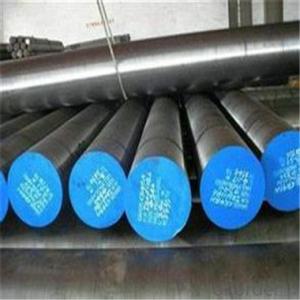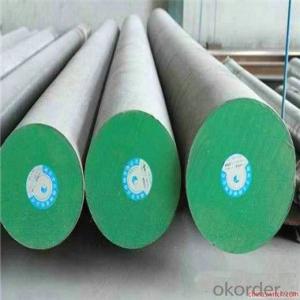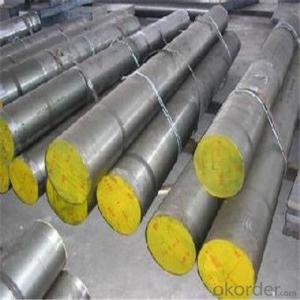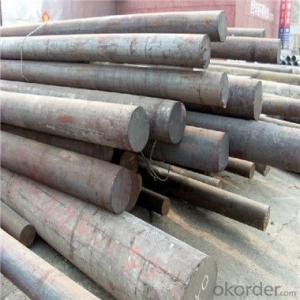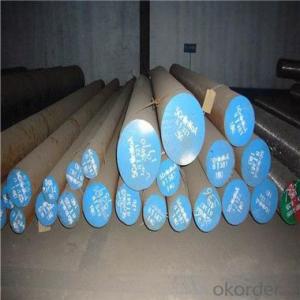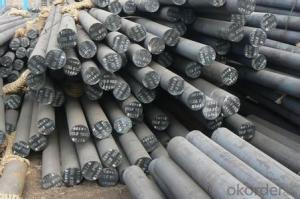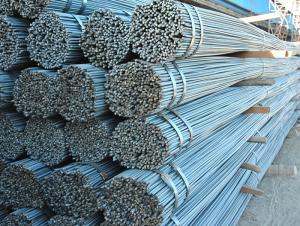S20C-B/S45C-B Steel Round Bar
- Loading Port:
- China main port
- Payment Terms:
- TT OR LC
- Min Order Qty:
- 5 m.t.
- Supply Capability:
- 100000 m.t./month
OKorder Service Pledge
OKorder Financial Service
You Might Also Like
Item specifice
Specifications
1. 2080
1. cold work mould/die steel
2. High carbon high chromium type ledeburite
3. High hardness wear resistance
Product description
1. Cr12 steel is a widely used cold work die steel, a type of high carbon high chromium ledeburite . The steel has good hardenability and good abrasion resistance
2. Mainly used to with stand the impact load is smaller, and require high abrasion resistance Die and punch, cold-cut scissors, drill sets, gauges, drawing die, pressure die thread rolling board, drawing die thread rolling die.
Chemical composition(for reference only)

Delivery of hardness and quenching hardness
Steel name | Delivery status | Quenched specimens | |||
Hardness HBW | Impressiondiameter (mm) | Quenching temperature/°C | Cooling medium | hardness ≥HRC | |
Cr12 | 269~217 | 3.7~4.1 | 950~1000 | oil | 60 |
Physical properties
Cr12 critical temperature
Critical point | Ac1 | Acm | Ar1 | Arcm | Ms |
temperature(approximation)/°C | 810 | 835 | 755 | 770 | 180 |
Cr12 Hot Working Technology
Item | Heating temperature/°C | start forging temperature/°C | final forging temperature/°C | type of cooling |
Steel ingot | 1140~1160 | 1100~1120 | 900~920 | Slow cooling |
Steel billet | 1120~1140 | 1080~1100 | 880~920 | Slow cooling |
Cr12 heat treatment
between the quenching temperature and the hardness of the relationship
quenching temperature/°C | 875 | 900 | 925 | 950 | 975 | 1000 | 1050 | 1100 |
Hardness HRC | 54.5 | 57 | 60 | 62.5 | 65 | 66 | 64 | 59.5 |
Delivery status: steel delivered in the annealed condition
We are professional manufacture of tool steel. We can provide various kinds of tool steel and mould steel. If you have any question regarding our products ,please feel free to let us know. We assure you will receive our best attention to your enquiry.
Products
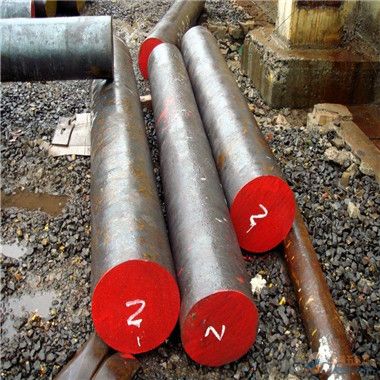
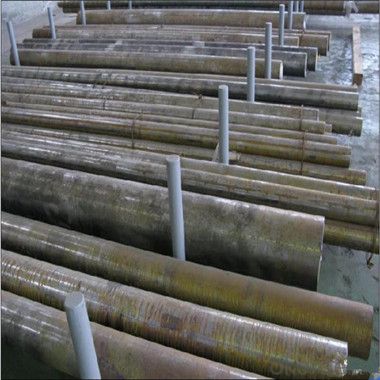
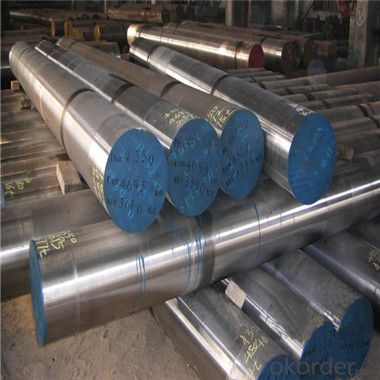
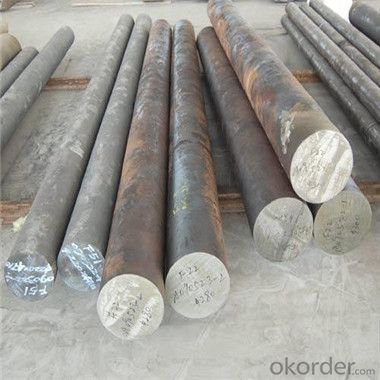
- Q:Are steel round bars suitable for bridge construction applications?
- Steel round bars are widely utilized in the construction of bridges. They possess numerous benefits for this purpose, such as their remarkable strength, durability, and versatility. These bars have the ability to withstand heavy loads and provide the essential structural support required for bridges. Furthermore, their fabrication and welding processes are easily manageable, resulting in efficient construction procedures. Incorporating steel round bars into bridge construction ensures the resistance of bridges to corrosion, a crucial aspect in environments exposed to moisture or severe weather conditions. Overall, steel round bars are an ideal and frequently employed material in bridge construction due to their strength, durability, versatility, and corrosion resistance.
- Q:Can steel round bars be hardened through heat treatment?
- Yes, steel round bars can be hardened through heat treatment. Heat treatment processes such as quenching and tempering can be used to change the microstructure of the steel, resulting in increased hardness and strength.
- Q:Q235 and mechanical properties of hot rolled steel cold drawn steel have what difference, Q235 hot rolled steel with 12 combined shearing machine has a number of very hard, the damage of the blades, why
- The difference between hot rolled steel and cold rolled steelHot rolled steel contains slightly higher carbon content than cold rolled steel. The density is the same in cases where the composition is not constant. But if the composition is different, such as stainless steel, whether cold-rolled or hot rolled steel, the density is about 7.9g/cm3. Specific depends on the ingredients, hot-rolled steel plate is only better ductility, steel is also under pressure.Hot-rolled steel is divided into structural steel, low carbon steel, welding bottle steel, and then according to various kinds of steel to find the steel that you need, check the density and composition of the specific steel.Hot rolled steel is low in hardness, easy to process and good in ductility.
- Q:Can steel round bars be used for making bearings?
- Steel round bars can indeed be used for making bearings. However, it is important to note that the specific type of steel used, as well as the manufacturing process, play a crucial role in determining the suitability of steel round bars for bearing applications. Bearings are typically subjected to high loads and require good wear resistance, low friction, and high durability. Steel round bars made from high-quality alloy steels, such as chrome steel or stainless steel, are commonly used for bearing manufacturing due to their excellent mechanical properties. These steel round bars undergo specific heat treatment processes, such as quenching and tempering, to enhance their hardness, strength, and wear resistance. Additionally, the round bars are typically machined to precise tolerances to ensure proper fit and alignment within the bearing assembly. It is important to consult with materials and manufacturing experts or refer to industry standards to ensure the appropriate steel round bar material and manufacturing processes are used for bearing applications. This will ensure the best performance, reliability, and longevity of the bearings in various operating conditions.
- Q:Can steel round bars be used for making shafts?
- Yes, steel round bars can be used for making shafts. Steel round bars are commonly used for their strength, durability, and machinability, making them suitable for shaft applications in various industries such as automotive, construction, and manufacturing.
- Q:What is the difference between a bright and a precision ground steel round bar?
- A bright steel round bar and a precision ground steel round bar are two different types of steel bars with distinct characteristics and manufacturing processes. The main difference between a bright steel round bar and a precision ground steel round bar lies in their surface finish and manufacturing tolerances. A bright steel round bar, also known as a bright mild steel bar or a bright mild steel round bar, undergoes a process called bright drawing. This process involves pulling the steel bar through a die to achieve a smooth and shiny surface finish. As a result, bright steel round bars have a highly polished appearance and a clean, smooth texture. They are commonly used in decorative applications, such as in the manufacturing of furniture, automotive accessories, and architectural elements. On the other hand, a precision ground steel round bar is manufactured with tight dimensional tolerances and precise surface finishes. These bars are typically made through the process of precision grinding, where the steel bar is machined to achieve a specific diameter and surface finish. Precision ground steel round bars are known for their accuracy and consistency in size, making them suitable for applications that require close tolerance and high precision, such as in the manufacturing of bearings, shafts, and hydraulic cylinders. In summary, the key difference between a bright steel round bar and a precision ground steel round bar lies in their surface finish and manufacturing tolerances. A bright steel bar has a polished appearance and is used primarily for decorative purposes, while a precision ground steel bar is machined to precise dimensions and is suitable for applications that require high precision and close tolerances.
- Q:Can steel round bars be heat treated to enhance their properties?
- Yes, steel round bars can be heat treated to enhance their properties. Heat treatment processes such as quenching, tempering, and annealing can be applied to steel round bars to increase their hardness, strength, and toughness. These treatments can also improve other properties like wear resistance and machinability, making the steel bars more suitable for specific applications.
- Q:What are the different international standards for steel round bars?
- There are several international standards that define the specifications and requirements for steel round bars. Some of the commonly used standards include: 1. ASTM A36/A36M: This standard covers carbon structural steel shapes, plates, and bars of structural quality for use in riveted, bolted, or welded construction of bridges and buildings. It specifies the chemical composition, mechanical properties, and dimensional tolerances for steel round bars. 2. ASTM A615/A615M: This standard specifies the requirements for deformed and plain carbon-steel bars for concrete reinforcement. It covers bars with sizes ranging from 6 to 60 mm in diameter and provides guidelines for chemical composition, mechanical properties, and bend tests. 3. BS 4449: This British Standard covers steel bars for the reinforcement of concrete. It outlines the requirements for carbon steel bars in various grades, including B500B and B500C. It specifies the tensile properties, chemical composition, and dimensional tolerances for these steel round bars. 4. DIN 17100: This German standard specifies the general structural steels, including steel round bars. It provides guidelines for the chemical composition, mechanical properties, and technical delivery conditions for different grades of steel bars. 5. JIS G3101: This Japanese Industrial Standard covers general structure rolled steel for various applications. It includes steel round bars and defines the chemical composition, mechanical properties, and dimensional tolerances for different grades of steel bars. 6. ISO 6935-2: This International Organization for Standardization standard specifies the requirements for hot-rolled steel bars for the reinforcement of concrete. It provides guidelines for the chemical composition, mechanical properties, and dimensional tolerances of steel round bars used in construction. These are just a few examples of the various international standards that exist for steel round bars. It is important to consult the appropriate standard based on the specific application and requirements to ensure compliance and quality of the steel round bars used.
- Q:What is the difference between a turned and a ground steel round bar?
- A turned steel round bar is a cylindrical steel rod that has been machined using a lathe to achieve a smooth and precise finish. This process removes material from the surface of the bar, resulting in a dimensional accuracy and a polished appearance. On the other hand, a ground steel round bar is also a cylindrical steel rod, but it undergoes a different machining process called grinding. Grinding involves using an abrasive wheel or belt to remove material from the bar's surface, resulting in a more precise diameter and a smoother finish compared to turning. In summary, the main difference between turned and ground steel round bars lies in the machining process used. Turning removes material through a lathe, while grinding involves an abrasive process for a more accurate and polished result.
- Q:What are the weight calculations for steel round bars?
- The weight calculations for steel round bars can be determined using a straightforward formula. The weight of a steel round bar can be calculated by multiplying the square of the diameter in millimeters by the length in meters and then multiplying the result by the specific weight of steel, which is typically around 7.85 grams per cubic centimeter. The formula for calculating the weight of a steel round bar is as follows: Weight = (Diameter^2 x Length x Specific Weight of Steel) / 1000 Where: - Diameter is the diameter of the round bar in millimeters - Length is the length of the round bar in meters - Specific Weight of Steel is the density of steel, which is usually 7.85 grams per cubic centimeter - 1000 is used to convert the weight from grams to kilograms It is important to note that this formula assumes the round bar is made of pure steel and does not account for any variations in the specific weight of different steel alloys. Additionally, it is crucial to use consistent units throughout the calculation, either millimeters or meters, to obtain accurate results.
1. Manufacturer Overview |
|
|---|---|
| Location | |
| Year Established | |
| Annual Output Value | |
| Main Markets | |
| Company Certifications | |
2. Manufacturer Certificates |
|
|---|---|
| a) Certification Name | |
| Range | |
| Reference | |
| Validity Period | |
3. Manufacturer Capability |
|
|---|---|
| a)Trade Capacity | |
| Nearest Port | |
| Export Percentage | |
| No.of Employees in Trade Department | |
| Language Spoken: | |
| b)Factory Information | |
| Factory Size: | |
| No. of Production Lines | |
| Contract Manufacturing | |
| Product Price Range | |
Send your message to us
S20C-B/S45C-B Steel Round Bar
- Loading Port:
- China main port
- Payment Terms:
- TT OR LC
- Min Order Qty:
- 5 m.t.
- Supply Capability:
- 100000 m.t./month
OKorder Service Pledge
OKorder Financial Service
Similar products
New products
Hot products
Hot Searches
Related keywords
